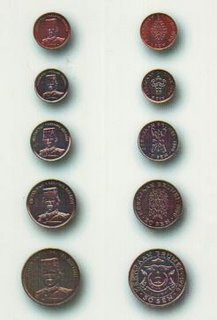Brunei Coins
 Someone asked in the chatter box, what is that design on the Brunei 10 cent coin? Rather than answering that question in the chatter box, I thought I will spend a whole entry on Brunei coins. We all have coins and have been holding them either in our pockets, purses, the small drawer in the car etc. But we never really know much about them and we always take them for granted. Today I thought we will spend a bit of time learning about the coins that we handled everyday.
Someone asked in the chatter box, what is that design on the Brunei 10 cent coin? Rather than answering that question in the chatter box, I thought I will spend a whole entry on Brunei coins. We all have coins and have been holding them either in our pockets, purses, the small drawer in the car etc. But we never really know much about them and we always take them for granted. Today I thought we will spend a bit of time learning about the coins that we handled everyday.First we look at the design of the coins. On the obverse side (this is the way coin faces are described - obverse refers to what we call the front) is always the potrait of His Majesty. The reverse side (that's the other face) are all those designs which are officially described as follows:
+ 50 cent coin - Crest of Brunei Darussalam;
+ 20 cent coin - A vertical oblong pattern based on local design and said to represent a tree;
+ 10 cent coin - Claw shaped (sepit ketam) local design and said to represent an animal;
+ 5 cent coin - Tree shaped local design and said to represent a bird; and
+ 1 cent coin - Local design and said to represent a flower or a group of blossoms.
There are currently 3 designs of coins being issued, the first one being issued in 1967 where the obverse design featured the portrait of the late Sultan Omar’ Ali Saifuddien Sa’adul Khairi Waddien while both the second and third issue of coins featuring the portraits of His Majesty Sultan Haji Hassanal Bolkiah Mu’izzaddin Waddaulah Sultan and Yang Di-Pertuan of Brunei Darussalam were issued in 1968 and 1993 respectively. The reverse designs for both issues were the same.
Here is something else you don't know. You must have seen or read a number of television shows or cartoons where someone who wants to get even with a shopkeeper pays large amounts with coins instead of notes. There is actually a legal limit to how much you can pay with coins. Coins are legal tender up to their face value with the following restrictions:-
+ $2 coin and above : any amount (but generally coins $1 and above are commemorative and always kept as collections - even though theoretically they are usable);
+ 50 cents and $1 coins : maximum $10; and
+ 20 cents, 10 cents , 5 cents and 1 cent coins : maximum $2.
So you can't pay someone $100 worth of one cents coins even if you want to get even. The other interesting fact is that I was told that the 1 cent coin is actually worth slightly more than the 1 cent value as the value of metal nowadays are much higher.
How can we tell if Brunei coins are genuine? There are two things you need to look at. The first is the tone and finish, other than the specifications of sizes and weights as gazetted if you have access to that information. It is said that a genuine coin will give a sharp ringing tone when dropped on a hard surface. Secondly, the relief of the design, milled edges (all have milled edges except for 1 cent coin), lettering and characters on both the obverse and reverse are very sharp and defined on genuine coins. The holding and passing of counterfeit coins is a criminal offence and the penalty is 7 years imprisonment and a fine.


Comments
Thanks for the very interesting account of Brunei coins. I've always wondered whether the patterns were decorative or had more to it.
BTW - just something maybe you all noticed (or hadn't). But the 1 cent coin is actually bigger in diameter than the 5cent coin.